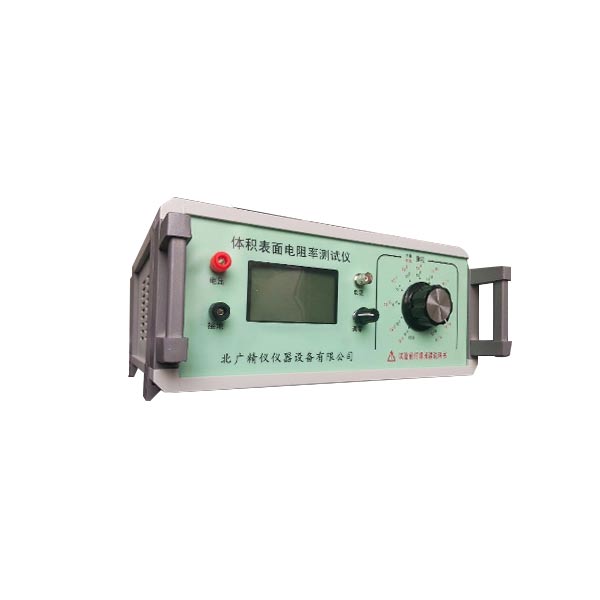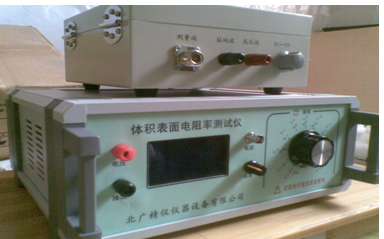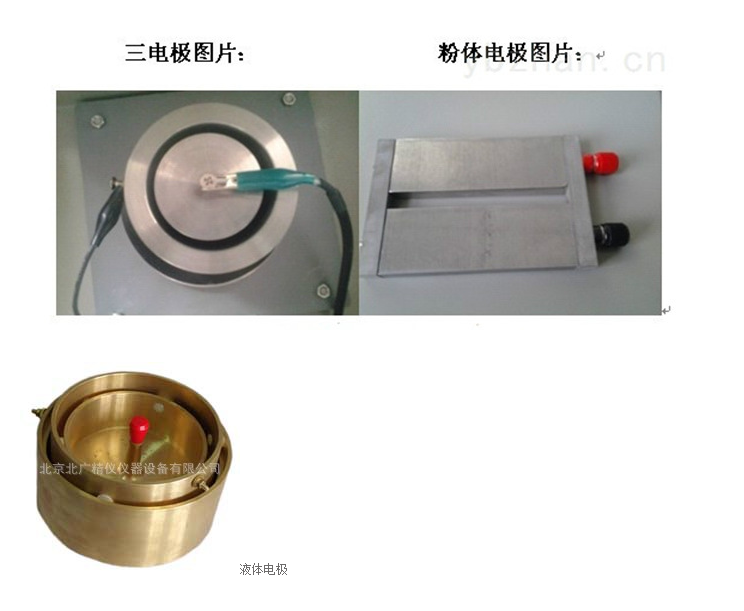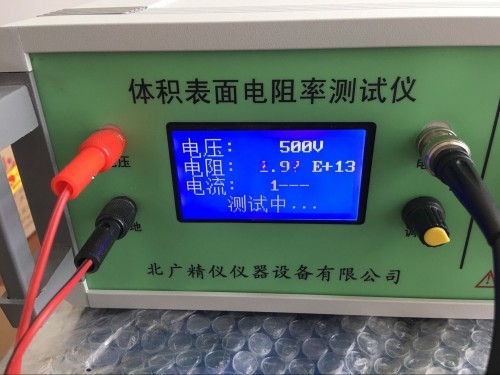
體積表面電阻率測試儀北京廠家 工作原理
根據歐姆定律,被測電阻Rx等于施加電壓V除以通過的電流I。BEST121型數字高阻計是同時測出電阻兩端的電壓V和流過電阻的電流I,通過內部的大規模集成電路完成電壓除以電流的計算,然后把所得到的結果經過A/D轉換后以數字顯示出電阻值,即便是電阻兩端的電壓V和流過電阻的電流I是同時變化,其顯示的電阻值不象普通高阻計那樣因被測電壓V的變化或電流I的變化而變,所以,即使測量電壓、被測量電阻、電源電壓等發生變化對其結果影響不大,其測量精度很高,從理論上講其誤差可以做到零,而實際誤差可以做到千分之幾或萬分之幾。
體積表面電阻率測試儀北京廠家 典型應用
1.硫化橡膠體積、表面電阻率測定
2.測量防靜電鞋、導電鞋的電阻值
3.測量防靜電材料的電阻及電阻率
4.測量計算機房用活動地板的系統電阻值
5.測量絕緣材料電阻(率)
6.光電二極管暗電流測量
7.物理,光學和材料研究
8.高分子材料表面體積電阻率測定
安全注意事項
1.使用前務必詳閱此說明書,并遵照指示步驟,依次操作。
2.請勿使用非原廠提供之附件,以免發生危險。
3.進行測試時,本儀器測量端高壓輸出端上有直流高壓輸出,嚴禁人體接觸 ,以
免觸電。
4.為避免測試棒本身絕緣泄漏造成誤差,接儀器測量端輸入的測試棒應盡可 能懸
空,不與外界物體相碰。
5.當被測物絕緣電阻值高,且測量出現指針不穩現象時,可將儀器測量線屏 蔽端夾子接 上。 例如: 對電 纜測纜 芯與 纜殼的 絕緣 時,除 將被 測物兩 端分 別接于 輸入 端與高壓 端, 再將電 纜殼 ,芯之 間的 內層絕 緣物 接儀器 “G”,以消 除因 表面漏 電而 引起的測 量誤 差。也 可用 加屏蔽 盒的 方法, 即將 被測物 置于 金屬屏 蔽盒 內,接 上測 量線。
技術指標
序號 項目 參數
1 電阻測量范圍 0.01?104Ω~1?1018Ω
2 電流測量范圍為 2?10-4A~1?10-16A
3 雙表頭顯示 3.1/2位LED顯示
4 內置測試電壓 100V、250V、500V、1000V
5 基本準確度 1% (*注)
6 內置測試電壓 100V、250、500、1000V
7 使用環境 溫度:0℃~40℃相對濕度<80%
8 供電形式 AC 220V,50HZ,功耗約5W
9 儀器尺寸 285mm?245mm?120 mm
10 質量 約2.5KG
符合標準
GB/T 1410-2006、GB 12014、GB/T 20991-2007、GB 4385-1995、GB 12158-2006、GB 4655-2003、GB/T 12703.4-2010、GB/T 12703.6-2010、GB 13348-2009、GB/T 15738-2008、GB/T 18044-2008、GB/T 18864-2002、GB/T 22042-2008、GB/T 22043-2008、GB/T 24249-2009、GB 26539-2011、GB/T 26825-2011、GB 50515-2010、GB 50611-2010、GJB 105-1998-Z、GJB 3007A-2009、GJB 5104-2004
溫度影響
溫度對不同物質的電阻值均有不同的影晌。
導電體在接近室溫的溫度,良導體的電阻值,通常與溫度成線性關系:
ρ=ρ0(1 αt)
上式中的a稱為電阻的溫度系數。
未經摻雜的半導體的電阻隨溫度升高而下降:
有摻雜的半導體變化較為復雜。當溫度從絕對零度上升,半導體的電阻先是減少,到了絕大部分的帶電粒子(電子或電洞/空穴) 離開了它們的載體后,電阻會因帶電粒子的活動力下降而隨溫度稍為上升。當溫度升得更高,半導體會產生新的載體 (和未經摻雜的半導體一樣) ,原有的載體 (因滲雜而產生者) 重要性下降,于是電阻會再度下降。
絕緣體和電解質絕緣體和電解質的電阻與溫度的關系一般不成比例,而且不同物質有不同的變化,故不在此列出概括性的算式。
測試電壓(V)
DC—10V
DC—50V
DC—100V
DC—500V
DC—1000V
標準配置:
1、儀器主機 一臺
2、屏蔽箱一個
3、試驗電極三個
4、說明書一本
5、電源線一條
6、數據線三條
7、合格證一份
8、保修卡一份
意義
1通常,絕緣材料用于將電氣系統的各部件相互絕緣和對地絕緣;固體絕緣材料還起機械支撐作用。
對于這些用途,一般都希望材料具有盡可能高的絕緣電阻,有均勻一致的、得到認可的機械、化學和耐熱
性能。表面電阻隨濕度變化很快,而體積電阻隨溫度變化卻很慢,盡管其終的變化也許較大
2體積電阻率能被用作選擇特定用途絕緣材料的一個參數。電阻率隨溫度和濕度的變化而顯著變
化,因此在為一些運行條件而設計時必須對其了解。體積電阻率的測量常被用于檢查絕緣材料生產是
否始終如一,或檢測能影響材料質量而又不能用其他方法檢測到的導電雜質
3 一直流電壓加在與試樣相接觸的兩電極之間時,通過試樣的電流會漸近地減小到一個穩定值。
電流隨時間的減小可能是由于電介質極化和可動離子位移到電極所致。對于體積電阻率小于
loll n"m的材料,其穩定狀態通常在一分鐘內達到,因此,經過這個電化時間后測定電阻。對于體積電
阻率較高的材料,電流減小的過程可能會持續到幾分鐘、幾小時、幾天甚至幾星期。因此對于這樣的材
料,采用較長的電化時間,且如果合適,可用體積電阻率與時間的關系來描述材料的特性.
4由于或多或少的體積電導總是要被包括到表面電導測試中去,因此不能精確而只能近似地測量表
面電阻或表面電導。測得的值主要反映被側試樣表面污染的特性。而且試樣的電容率影響污染物質的
沉積,它們的導電能力義受試樣的表面特性所影響。。因此,表面電阻率不是一個真正意義的材料特性,
而是材料表面含有污染物質時與材料特性有關的一個參數。
某些材料如層壓材料在表面層和內部可能有很不同的電阻率,因此測量清潔的表面的內在性能是
有意義的。應完整地規定為獲得一致的結果而進行清潔處理的程序,并要記錄清潔過程中溶劑或其他
因素對于表面特性可能產生的影響。
表面電阻,特別是當它較高時,常以不規則方式變化,且通常非常依賴于電化時間。因此,測量時通
常規定一分鐘的電化時間。
注意事項
絕緣電阻儀器體積電阻表面電阻測試儀使用前請仔細閱讀以下內容,否則將造成儀器損壞或電擊情況。
1.◇檢查儀器后面板電壓量程是否置于10V檔,電流電阻量程是否置于104檔。
2.◇接通電源調零,(注意此時主機不得與屏蔽箱線路連接)在“Rx”兩端開路的情況下,調零使電流表的顯示為0000。然后關機。
3.◇將待測試樣平鋪在不保護電極正中央,然后用保護電極壓住樣品,再插入被保護電極(不保護電極、保護電極、被保護電極應同軸且確認電極之間無短路)。
4.◇測體積電阻時測試按鈕撥到Rv邊,測表面電阻時測試按鈕撥到Rs邊,
5.◇接好測試線,將測試線將主機與屏蔽箱連接好。量程置于104檔,打開主機后面板電源開關按鈕。從儀器后面板調電壓按鈕到所要求的測量電壓。(比如:GBT 1692-2008硫化橡膠 絕緣電阻率的測定 標準中注明要求在500V電壓進行測定,那么電壓就要升到500V)
6.◇電流電阻量程按鈕從低檔位逐漸撥高檔,每撥一次停留1-2秒觀察顯示數字,當被測電阻大于儀器測量量程時,電阻表顯示“1”,此時應繼續將儀器撥到量程更高的位置。測量儀器有顯示值時應停下,在1min的電化時間后測量電阻,當前的數字乘以檔次即是被測電阻。
7.◇測試完畢先將量程撥至(104)檔,然后將測量電壓撥至10V檔, 后將測試按鈕撥到中央位置后關閉電源。然后進行下一次測試。

8.◇應在“Rx”兩端開路時調零,一般一次調零后在測試過程中不需再調零。
9.◇禁止將“RX”兩端短路,以免微電流放大器受大電流沖擊。
10.◇不得在測試過程中不要隨意改動測量電壓。
11.◇測量時從低次檔逐漸撥往高次檔。
12.◇接通電源后,手指不能觸及高壓線的金屬部分。
13.◇不得測試過程中不能觸摸微電流測試端。
14.◇在測量高阻時,應采用屏蔽盒將被測物體屏蔽。
15.◇嚴禁在試測過程隨意改變電壓量程及在通電過程中打開主機。
16.◇嚴禁電流電阻量程未在104檔及電壓在10V檔,更換試樣。
working principle
According to Ohm's Law, the measured resistance Rx is equal to the applied voltage V divided by the current I passing through. The BEST121 digital high resistance meter simultaneously measures the voltage V across the resistor and the current I flowing through the resistor. It calculates the voltage divided by the current through an internal large-scale integrated circuit, and then displays the resistance value digitally after A/D conversion. Even if the voltage V across the resistor and the current I flowing through the resistor change at the same time, the displayed resistance value does not change due to changes in the measured voltage V or current I like ordinary high resistance meters. Therefore, even if there are changes in the measured voltage, measured resistance, power supply voltage, etc. that have little impact on its results, its measurement accuracy is very high. Theoretically, its error can be zero, while the actual error can reach a few thousandths or tens of thousands.
Typical applications
1. Determination of volume and surface resistivity of vulcanized rubber
2. Measure the resistance value of anti-static shoes and conductive shoes
3. Measure the resistance and resistivity of anti-static materials
4. Measure the system resistance value of the raised floor used in the computer room
5. Measure the resistance (rate) of insulation materials
6. Measurement of dark current in photodiodes
7. Physics, optics, and materials research
8. Measurement of surface volume resistivity of polymer materials
Safety precautions
1. Before use, be sure to read this manual carefully and follow the instructions in sequence.
2. Do not use accessories not provided by the original factory to avoid danger.
During testing, there is a DC high voltage output on the high voltage output terminal of the measuring end of this instrument. It is strictly prohibited for human contact
No electric shock.
To avoid errors caused by insulation leakage of the test rod itself, the test rod connected to the measuring end of the instrument should be suspended as much as possible
Empty, not colliding with external objects.
When the insulation resistance value of the measured object is high and the pointer is unstable during measurement, the shielding end clamp of the instrument measurement line can be connected. For example, when measuring the insulation between the cable core and the cable shell, in addition to connecting the two ends of the measured object to the input end and the high voltage end respectively, the inner insulation between the cable shell and core is connected to the instrument "G" to eliminate measurement errors caused by surface leakage. Alternatively, the method of adding a shielding box can be used, which involves placing the object under test in a metal shielding box and connecting the measuring wire.
Technical indicators
Number Project Parameters
1. Resistance measurement range 0.01?104Ω~1?1018Ω
The current measurement range is 2?10-4A to 1?10-16A
3 Dual Header Display 3.1/2 LED Display
Built in testing voltages of 100V, 250V, 500V, and 1000V
5 basic accuracy 1% (* note)
6 built-in test voltages of 100V, 250, 500, 1000V
7. Operating environment temperature: 0℃~40℃, relative humidity<80%
8 power supply form AC 220V, 50HZ, power consumption of about 5W
9 Instrument dimensions 285mm?245mm?120mm
10 mass approximately 2.5KG
Compliant with standards
GB/T 1410-2006、GB 12014、GB/T 20991-2007、GB 4385-1995、GB 12158-2006、GB 4655-2003、GB/T 12703.4-2010、GB/T 12703.6-2010、GB 13348-2009、GB/T 15738-2008、GB/T 18044-2008、GB/T 18864-2002、GB/T 22042-2008、GB/T 22043-2008、GB/T 24249-2009、GB 26539-2011、GB/T 26825-2011、GB 50515-2010、GB 50611-2010、GJB 105-1998-Z、GJB 3007A-2009、GJB 5104-2004
Temperature influence
Temperature has different effects on the resistance values of different substances.
At temperatures close to room temperature, the resistance value of a good conductor is usually linearly related to temperature
ρ=ρ0(1 αt)
The 'a' in the above equation is called the temperature coefficient of resistance.
The resistance of undoped semiconductors decreases with increasing temperature:
The changes in doped semiconductors are more complex. When the temperature rises from absolute zero, the resistance of the semiconductor first decreases, and after the majority of charged particles (electrons or holes/holes) leave their carriers, the resistance slightly increases with temperature due to the decrease in the activity force of the charged particles. When the temperature rises higher, semiconductors will produce new carriers (like undoped semiconductors), and the importance of the original carriers (generated due to doping) will decrease, resulting in a further decrease in resistance.
The relationship between the resistance of insulators and electrolytes and temperature is generally not proportional, and different substances have different changes, so a general formula is not listed here.
Test voltage (V)
DC—10V
DC—50V
DC—100V
DC—500V
DC—1000V
Standard configuration:
1. One instrument host
2. One shielding box
3. Three experimental electrodes
4. One manual
5. One power cord
6. Three data cables
7. One certificate of conformity
8. One warranty card
significance
Usually, insulation materials are used to insulate the various components of an electrical system from each other and from the ground; Solid insulation materials also serve as mechanical support.
For these applications, it is generally desirable for materials to have the highest possible insulation resistance, with uniform and recognized mechanical, chemical, and heat resistance
Performance. The surface resistance changes rapidly with humidity, while the volume resistance changes slowly with temperature, although its final change may be significant
Volume resistivity can be used as a parameter for selecting insulation materials for specific applications. The resistivity changes significantly with temperature and humidity
Therefore, it is necessary to understand it when designing for certain operating conditions. The measurement of volume resistivity is often used to check the production of insulation materials
Whether it is consistent or detecting conductive impurities that can affect material quality but cannot be detected by other methods
When a DC voltage is applied between the two electrodes in contact with the sample, the current passing through the sample will asymptotically decrease to a stable value.
The decrease in current over time may be due to dielectric polarization and the displacement of movable ions to the electrode. For volume resistivity less than
The material of loll n "m usually reaches a stable state within one minute, so the resistance is measured after this electrification time. For volume electricity
The process of reducing current in materials with high resistivity may last for several minutes, hours, days, or even weeks. Therefore, for such materials
Material, using a longer electrochemical time, and if appropriate, the relationship between volume resistivity and time can be used to describe the characteristics of the material
Due to the fact that more or less volume conductivity is always included in surface conductivity testing, it cannot be accurately measured and can only be approximately measured
Surface resistance or surface conductivity. The measured values mainly reflect the characteristics of surface contamination of the side sample. Moreover, the capacitance of the sample affects the contamination of the substance
Sedimentation, their conductivity is influenced by the surface characteristics of the sample.. Therefore, surface resistivity is not a true material property,
But it is a parameter related to the material properties when the surface of the material contains pollutants.
Some materials, such as laminates, may have very different electrical resistivity in the surface layer and interior, so measuring the intrinsic properties of a clean surface is important
meaningful. The procedure for cleaning to achieve consistent results should be fully defined, and the solvents or other substances used during the cleaning process should be recorded
The possible impact of factors on surface characteristics.
Surface resistance, especially when it is high, often changes irregularly and is often highly dependent on electrochemical time. Therefore, during measurement, communication is necessary
Regularly set a one minute electrification time.
matters needing attention
Before using the insulation resistance instrument, volume resistance surface resistance tester, please carefully read the following content, otherwise it may cause damage to the instrument or electric shock.
1.◇Check if the voltage range on the back panel of the instrument is set to 10V and if the current resistance range is set to 104.
2.◇Connect the power and zero it (note that the host should not be connected to the shielding box circuit at this time). In the case of an open circuit at both ends of "Rx", zero it to display 0000 on the ammeter. Then shut down.
3. Lay the test sample flat in the center of the unprotected electrode, then press the sample with the protective electrode, and insert the protected electrode (the unprotected electrode, protective electrode, and protected electrode should be coaxial and confirm that there is no short circuit between the electrodes).
When measuring volume resistance, turn the test button to the Rv side, and when measuring surface resistance, turn the test button to the Rs side,
5. Connect the test cable and connect the host to the shielding box. Set the range to 104 and turn on the power switch button on the back panel of the host. Adjust the voltage button on the back panel of the instrument to the required measurement voltage. (For example, in the GBT 1692-2008 standard for measuring the insulation resistivity of vulcanized rubber, it is specified that the measurement should be carried out at a voltage of 500V, so the voltage should be raised to 500V.)
6.◇Gradually shift the current resistance range button from low to high, and hold for 1-2 seconds each time to observe the displayed number. When the measured resistance is greater than the instrument's measurement range, the resistance meter will display "1". At this time, continue to move the instrument to a higher range position. When the measuring instrument displays a value, it should stop and measure the resistance after 1 minute of electrification time. The current number multiplied by the level is the measured resistance.
After the test is completed, first set the range to (104), then set the measured voltage to 10V, and finally turn off the power after setting the test button to the center position. Then proceed to the next test.
8. It should be zeroed when there is an open circuit at both ends of "Rx". Generally, after one zeroing, there is no need to zero again during the testing process.
9.◇It is forbidden to short-circuit the "RX" at both ends to prevent the microcurrent amplifier from being impacted by high currents.
10.◇Do not arbitrarily change the measured voltage during the testing process.
11. During measurement, gradually shift from low gear to high gear.
After connecting the power supply, fingers should not touch the metal parts of the high-voltage line.
13.◇Do not touch the microcurrent testing terminal during the testing process.
When measuring high resistance, a shielding box should be used to shield the object being measured.
15.◇It is strictly prohibited to change the voltage range arbitrarily during the testing process and to turn on the host during the power on process.
16.◇It is strictly prohibited to replace the sample if the current resistance range is not in the 104 range and the voltage is in the 10V range.
業務咨詢:932174181 媒體合作:2279387437 24小時服務熱線:15136468001 盤古機械網 - 全面、科學的機械行業免費發布信息網站 Copyright 2017 PGJXO.COM 豫ICP備12019803號